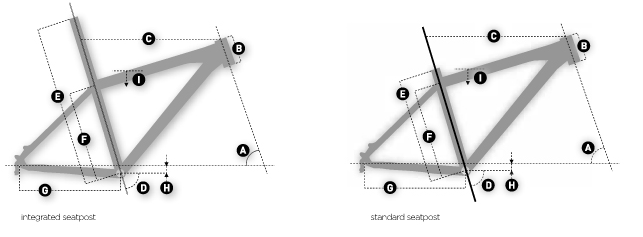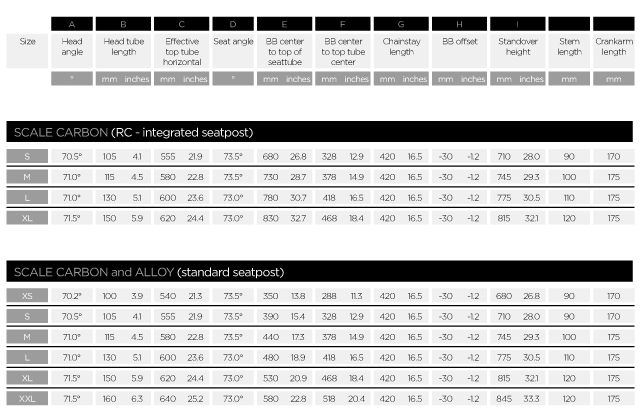Frame geometry?
Oxygen Thief
Posts: 649
When you lot talk about frame geometry what you referring to exactly? Now I know what the frame is and I know what geometry is so I get that much.
But do you talk about it just by looking at the and saying ah yes that's like this and that to make the bike behave like ____?
Or do you read the spec and see something there?
Or google the frame and check out the angles etc?
I'm a bit confused. Reason I ask is I'd like to start thinking about my riding style and what frames may be best for me etc
Cheers
But do you talk about it just by looking at the and saying ah yes that's like this and that to make the bike behave like ____?
Or do you read the spec and see something there?
Or google the frame and check out the angles etc?
I'm a bit confused. Reason I ask is I'd like to start thinking about my riding style and what frames may be best for me etc
Cheers
0
Comments
-
you compare something that you know to something that you want.
but you need to know how they measure things.
but for a different riding style then you need to look at a totally different style of bike and then start comparing them and test ride."Do not follow where the path may lead, Go instead where there is no path, and Leave a Trail."
Parktools :?:SheldonBrown0 -
I don't know much though. And wouldn't know what I would be looking to compare. Just when you see wrote those two bikes have completely different geometry for example but I look at two pictures of them and think hmmmmm I wonder how???
Two bikes I saw this written for and made me wonder was the GT Agressor XC2 and a Giant XTC4.
Now, I know that the XTC 4 is built to be quick and manoeuvrable yeah? But to me the GT looks so similar in frame shape that I'd think it would be similar to ride, but that's not the case? So what is different about the two frames I was wondering? Or am I just blind? lol0 -
-
My understanding is limited but this is how I understand it. Two frames may look similar but the changes only need to be subtle for it to make a difference in feel and handling.
Geometry refers to, the as the name suggests, the geometry of the frame, i.e. the seat post angle, steering tube angle, the size of the rear triangle, top tube length, bottom bracket height, etc. Basically all the dimensions that make up the overall shape of the frame.
Slacker angles are supposed to be more more relaxed and less responsive in the steering compared to an aggressive geometry which is more 'nervous' and used more for XC racing. The difference can be small only 2-3deg on the steering tube and seat post angles so not easy to spot just by looking at a frame unless you're experienced - which I'm not BTW. DH bike have slacker angles. Smaller or tighter rear triangles also influence the way the bike rides although I'm not sure what the differences in handling are.
That's my limited understanding. I'd be interested to hear more from someone more experienced.0 -
The most important aspect of geometry when establishing handling is the head angle, and the rear "stay" length (also wheelbase).0
-
Right... now I'm getting it. From what you have said and from the info BigBenj has posted. So the Giant has slightly tighter angles. 0.5 degree to be exact. That seems very marginal don't it for the two to have completely different frame geometry's?!
But then the Giant has a bigger wheelbase, that obviously plays a role in handling etc.
But still couldn't work out what the result would be of those measurements for the way each bike is intended to be used? Anyone?0 -
-
true, geometry only gives an idea of how it might handle.0
-
yup... too many other variables...
stem length, stem rise,bar width, bar rise, stack height, fork height, crank length..........0 -
So there's no kind of general rule to it? That's a bit annoying! lol
There must be some, such as shorter wheelbase is going to give you quicker handling? Even if it's rubbish and too unstable. Just wondering how people can say that this bike is made for that and this other one for something different. I read that DH bikes have slacker angles. Slacker angles = more stabilty at higher speeds I'm guessing?
When people say go out and try them, it's not like you can try them through the mountains though is it or out on the trails? Riding around outside a shop is there any difference to be seen? I wouldn't know how to tell. lol0 -
well, generally, slacker head angle means more stability at speed, and better capability over really rough trails.
Likewise, a long back end makes the bike more stable, shorter one makes it twitchier.0 -
Slacker = more stability pointing downwards with long travel....
short wheelbase is quicker steering but more unstable at speed.
you keep mentioning DH but both the above bikes are xc!
Short wheelbase is also used in 4x/dj because its easier to throw them around.0 -
Lol, yeah I know but I was going towards the extreme of one end in DH with slack angles, if I was right in what I wrote about them then the opposite would be true for the 2 above. Slacker angles so less manoeuvrable but bit more stable at speed for DH, opposite for XC as in the two above.
So there can't be any real difference in the two above frame geometry's if they're both XC as both should be doing pretty much the same?! The Giant is slightly tighter angled so going to be easier to throw about. But it also has a longer wheelbase? That would prob cancel out some of that ability to be thrown about. All very confusing I must say! Interesting though.
Cheers for the info by the way.0 -
no, slacker angles slow down handling, meaning they're less manoeuvrable. Too slack an angle makes it a pain to get round tight switchbacks.0
-
That's what I meant yeah. Getting late. Will edit it as I meant it0
-
like I said.. you'd really need to sit on the bike to see!
Assuming the measurements are taken in the same way: the GT has a lower and shorter top tube, giving a more relaxed fit with more clearance.... coupled with shorter wheelbase I'd expect it to be a bit more lively and a bit more aggressive.
The Giant is a bit more racey/stretched out, possibly giving a more stable platform for xc duties.
Remember the Giant only takes a 100mm fork and the GT a 120mm fork so you have to take that into account too... its comparing 2 fairly different bikes!0 -
Yeah I was thinking that, think it's just that what I read contradicted that and said the Giant was the 'quicker' XC bike. That threw me then when looking at the measurements because everything looked to say the GT would be like you say the more aggresive bike.
I think I'm getting there now. Cheers again. Makes a hell of a lot more sense actually, and will be better equipped when looking at bikes and considering my style of riding. It's bloody hard work finding geometry measurements for bikes on the net though! Looking for a few just to have a little gander really and getting jack! :-)
Cheers lads0 -
purely from eyeballing it (which is frequently wrong) the GT looks to have a slightly more laid back head angle, and a shorter back end, Also the seat tube is sloping backwards more, so I'd expect it to be more aggressive - by which I mean, happier to be thrown down rocky trails at speed, but still remain "chuckable" so you could throw it around more.
It might need the rider to make a more conscious forward weight shift when cornering though.0 -
Yeah I can get that. Doesn't tie in with the figures though as the angles are tighter on both those measurements on the Giant which would suggest the opposite. :-/0
-
hahal. I told you the old eyeball was frequently wrong!
Looking at my own bike which has a very laid back head angle, it's hard to tell the difference in the pictures.0 -
Haha, it's all a bit mad. I get it more now though. Sure it'll all become clearer as I get more un-noob

Cheers0 -
For comparison, here are figures of the Scott Scale XC race bike which is supposed to have an aggressive geometry.

 0
0 -
Of course, depending on the bike's intended use, "aggressive" can mean two different things. I've heard DH bikes with a very slack head angle called "aggressive" as well as XC bikes, with a very steep head angle called "aggressive" :?0
-
yeehaamcgee
I think that's where the confusion is coming from. I think it's best that we take aggressive to mean something that is desgined for slightly harder riding, and being chucked about (GT). And we use 'racey' to describe something like a Scott Scale or the Giant, which is designed to be faster over smoother terrain, it'll be slightly steeper, probably longer too. So the steering will be more twitchy/responsive, but it won't be as stable on steep descents.0 -
Look at the fork length the GT is measuring with - 428mm. What is the giant? Is it sagged?
SO the GT with a 480mm fork ie a typical 100mm unit has 2 inches more front end heigh now. That slings the angles back 2 degrees.0 -
There's way too much confusion for me. That Scott has a head angle of 71 on the large, the GT has 71 and the Giant 70.5
Seat angle - Scott 73, GT 73.5 and Giant 73.
There's no wheelbase as far as I can see for the Scott so going on top tube, the Giant has longest, with the GT and Scott about 20mm shorter.
So would I be right in thinking that the top tube angle being more upright in the Scott and GT makes you kind of lean forward more, or shall we say forces you more naturally to have an aggressive stance, attack position friendly sort of?
The seat angle, again the GT is more upright forcing you forward on the bike? Attacking stance again.
Top tube length, shorter on the GT and Scott so again same kind of thing, also smaller bike more than likely with shorter wheelbase meaning easier to throw about. Giant longer so more 'comfortable' ride, rides the bumps a bit better in XC on the flat at speed?
Right tracks?0 -
Top tube angle?
The seat tube angle determines how you sit in relation to the bottom bracket. But you can move the saddle of course. Steeper generally does sit you foraward into the bike more.
But again you must consdier the fork length.0 -
Head tube angle I meant.
So a longer fork would change the angles. I'm just going to have to accept that point 'coz I can't see how.0 -
Put a 3 foot travel fork on the bike. The angles will now be very slack.0
-
0



